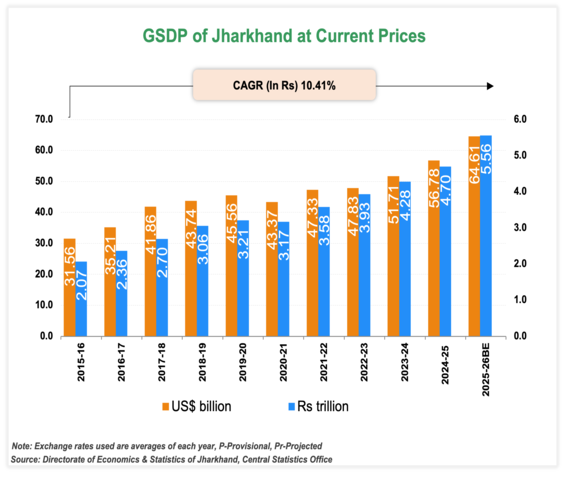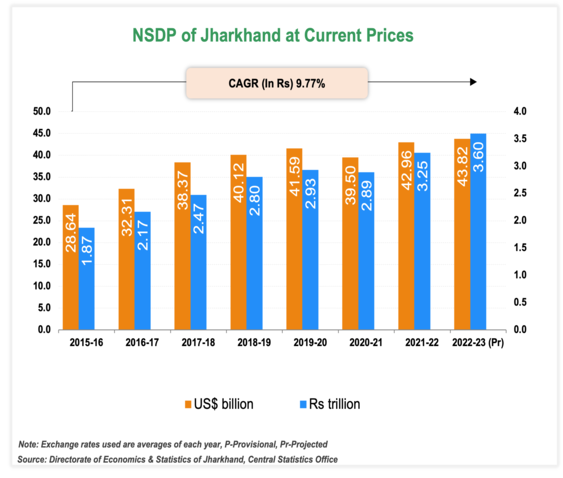Jharkhand is in the eastern part of India. The natural resources, policy incentives and location-specific advantages of Jharkhand support investments in sectors such as mining and metal extraction, engineering, iron and steel, and chemicals. At current prices, Jharkhand’s gross state domestic product (GSDP) was estimated to stand at ~Rs. 5.56 trillion (US$ 64.61 billion) in FY26. The GSDP increased at a CAGR of 10.41% between FY16 and FY26.
Jharkhand is rich in mineral resources such as coal (27.3% of India’s reserves), iron ore (26% of India’s reserves), copper ore (18.5% of India’s reserves), uranium, mica, bauxite, granite, limestone, silver, graphite, magnetite, and dolomite. Since Jharkhand has around 40% of the country's mineral wealth, its extensive mineral resources make mining, metals, and related sectors especially lucrative for investments. Jharkhand is the only state in India to produce coking coal, uranium, and pyrite. The state is also a leading producer of coal, mica, kyanite and copper. Jharkhand is the largest producer of tussar silk (non-mulberry silk) in India. Mineral production in the state stood at 138.15 million tonnes in FY23.
The state’s coal reserves are estimated at around 33 billion tonnes. Jharkhand accounts for 20-25% of the total steel produced in the country. In FY22, Jharkhand produced 72 thousand tonnes of limestone which was valued at Rs. 35,005 (US$ 0.42 million).
The state is the largest producer of tussar silk (non-mulberry silk) in the country with a 76.4% share in the total output. The state's raw silk production stood at 2,402 MT in FY20, 2184 MT in FY21 and 1,046 in FY22.
According to the Department for Promotion of Industry and Internal Trade (DPIIT), cumulative foreign direct investment (FDI) inflows in Jharkhand stood Rs. 22,903 crore (US$ 2.66 billion) between October 2019-Dec 2024.
As of March 2023, the number of IEMs filed were 3 and the value of proposed investments stood at Rs. 424 crore (US$ 51.6 million).
Total exports from the state stood at Rs. 15,498 crore (US$ 1.8 billion) in FY25 (Until Feb).
Major items exported from Jharkhand are Engineering Goods, Mica, Coal and Other Ores, Minerals Including Process, and Iron Ore.
As of FY25 (Until March), Jharkhand had a total installed power generation capacity of 3008.35 MW, comprising 800.01 MW under private utilities, 554.05 MW (state utilities), and 1654.29 MW (central utilities).
Under the State Budget FY26, Rs. 5,005 crore (US$ 581.3 million) has been allocated as power subsidy for consumers.
According to the Telecom Regulatory Authority of India (TRAI), Bihar including Jharkhand had 94.86 million wireless and 1.37 million wireline subscribers, as of Dec 2024.
As of Dec 2024, teledensity in the state stood at 56.44%.
The following are some of the major initiatives taken by the Government to promote Jharkhand as an investment destination:
- Major allocation under state budget FY26:
- Rs. 5,300 crore (US$ 615.6 million) has been allocated as capital outlay on roads and bridges.
- Rs.130 crore (US$ 15.1 million) has been allocated for urban transport systems and civic amenities in Urban Local Bodies (ULBs) and Rs. 200 crore (US$ 23.2 million) for other amenities.
- Rs. 2,057 crore (US$ 238.9 million) has been allocated towards Sarva Siksha Abhiyan.
- Rs. 1,769 crore (US$ 205 million), while the National Ayush Mission has been allocated Rs. 168 crore (US$ 19.5 million).
- Rs. 212 crore (US$ 24.6 million) for the State Horticulture Development Scheme and Rs. 140 crore (US$ 16.3 million) for distributing agricultural equipment to farmers and women self-help groups (SHGs).
- In September 2024, the central government announced a budget of over Rs. 7,000 crore (US$ 839.33 million) for the development of rail infrastructure in Jharkhand.
- In four years (2018-19 and 2021-22), Jharkhand attracted new investment proposals of over Rs. 1.10 lakh crore (US$ 13 billion) completed projects of Rs. 52,893 crore (US$ 6.45 billion) and revived pending proposals worth Rs. 287.45 crore (US$ 35.1 million), according to the study jointly conducted by the MSME Export Promotion Council and the Confederation of Organic Food Producers & Marketing Agencies (COII).
- Union Minister of Roads Transport and Highways, Mr. Nitin Gadkari, in March 2023, promised to bolster infrastructure in Jharkhand and asserted that Rs. 2 lakh crore (US$ 24 billion) highway network will be rolled out in the state by 2024.
- Prime Minister Mr. Narendra Modi inaugurated the Deoghar airport in July 2022, which has been constructed at an estimated cost of Rs. 400 crore (US$ 48.8 million). The Terminal Building of the airport is equipped to handle over five lakh passengers annually.
- The Jharkhand government unveiled an ambitious new solar policy (Jharkhand Solar Policy, 2022) which is aimed at increasing clean energy capacity up to 4,000 megawatts in the next five years.
- As per the State Budget 2024-25, the government allocated Rs. 6,017 crore (US$ 726.69 million) for the agriculture and allied activities sector.
- As per the State Budget 2024-25, Rs. 7,232 crore (US$ 873.43 million) has been allotted to the health & family welfare sector.
- A slew of road projects, measuring a collective length of 752 km and worth Rs. 13,299 crore (US$ 1.62 billion) were inaugurated, and their foundation stones were laid in March 2023 in Jharkhand.
- Under the State Budget 2024-25, Rs. 6389 crore (US$ 771.62 million) has been allocated towards roads and bridges projects in the state.
- In September 2019, the second Multi-Modal Terminal built at Sahibganj in Jharkhand was inaugurated, which was constructed on the river Ganga under the Jal Marg Vikas Project (JMVP).
- Two SEZs were notified first at Adityapur (adjoining Jamshedpur) for the automotive industry and second at Adani Power (Jharkhand) Ltd. for the power industry.
- As of November 2023, 13,715 habitations were eligible under Pradhan Mantri Gram Sadak Yojana (PMGSY), out of which 10,935 were sanctioned and further 10,954 habitations were connected.














